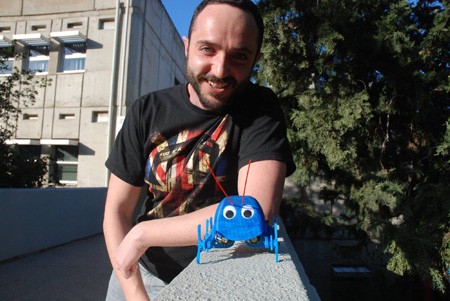Billy and Charlie are Making it Big
The two robots built by Ph.D. student Jonathan Spitz of the Technion’s Faculty of Mechanical Engineering are climbing over obstacles and up and down slopes
In the begining there was Billy – a blue robot 10 cm high and 15 cm long. At the end of his ‘gestation’ – a month of planning, printing, programming, wiring electronics and correcting defects – he began to walk and clamber over obstacles. He was soon joined by his fellow green robot, Charlie. The two wander all over campus guided by Jonathan Spitz, their ‘father,’ who maneuvers them using his smartphone. They are capable of traversing rough terrain such as rocks, sand and steep slopes.
Spitz, a Ph.D. student at the Faculty of Mechanical Engineering, was born in Argentina and came to Israel following high school, to the Atid program. “This decision was a combination of Zionism, which I absorbed at home and in a youth movement, and the desire to study at the Technion. The Technion is a very famous institution among Jews in Argentina, and many teens want to come to Israel to study here.”
Thirteen years have passed since Jonathan landed in Israel, and he remembers that day very well. “I left Argentina on December 23, 2002, on a 20-hour flight that landed at Ben Gurion Airport at 3:00 in the morning. From there I went to an absorption center in Kfar Sava.” In June 2003 Jonathan completed a Hebrew language study program and in October began his studies at the Technion. After earning a B.Sc. in mechanical engineering, he enrolled in the M.Sc. program and in 2012 started his Ph.D. studies, which he hopes to complete soon. “The Technion is very close to my heart,” he says. “There are students who count the days until they finish their degree, but I am actually enjoying myself. I didn’t stay here for three degrees in a row without good reason.”
Jonathan is conducting his Ph.D. research in the SMILE lab at the Faculty of Mechanical Engineering, under the guidance of Miriam Zacksenhouse. “Today we have means at our disposal that were not available only a few years ago: tremendous computing power and 3D printers,” explains Jonathan. “True, mechanical design is still the same complicated task, but 3D printing lets you create very complex structures ‘at home’ at very low cost. Each of the robots I made cost me about $200. That’s all.”
Jonathan developed Billy and Charlie during his spare time (“They’re not part of my Ph.D.”) in order to prove the feasibility of building sophisticated mobile robots. Jonathan promoted the use of 3D printers in his lab in order to create ambulatory robots that would demonstrate the control methods he designed. He developed the robot’s gait based on his observation of nature. “Human beings walk from age one or two, such that to them walking seems to be the simplest of actions – at least on level surfaces. Humans only have to concentrate on their steps on difficult terrain. The controller that I developed also works without any need for feedback on smooth, horizontal surfaces, and when the robots walk on slopes it uses minimal feedback.” In order to make his robots walk, Jonathan built a ‘genetic algorithm’ – an algorithm that evolves better controllers following the principles of natural selection.
“My success is in building robots with high navigability; that are inexpensive and which can therefore also be built as ‘swarms’ of robots for various security uses and for assisting and treating people who are ill. The control method that I designed (and which has been patented) can be applied to both humanoid robots and medical robots (such as ReWalk) and robots for walking rehabilitation. In order to put this idea into practice and make it commercially viable, I have entered the BizTEC competition and applied to the Runway program at Cornell-Technology.”




